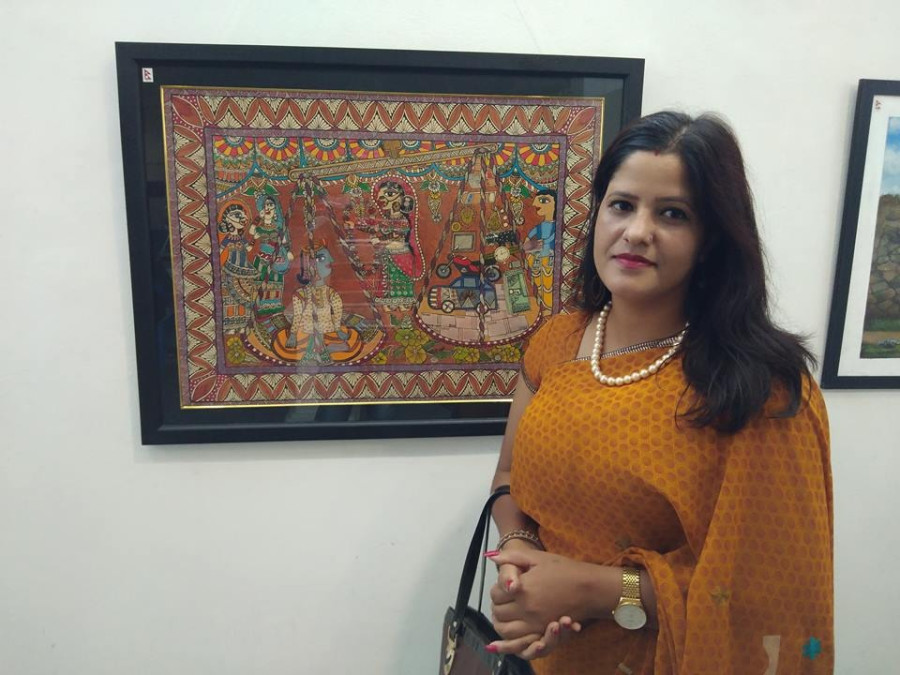Arts
Mithila art as a medium of empowerment
Artist Ranju Yadav discusses the history and representation of women in Mithila arts.
Kshitiz Pratap Shah
Mithila art, also known as Madhubani paintings, is known for its unique style, grid-like patterns, and vibrant colours and shapes. Yet, a significant aspect of this art form rarely brought to the forefront is the role of many women in its creation. Mithila art has always been for women, although there has been little representation of their real-life issues.
Artist Ranju Yadav laments this issue. She claims, “Women have created ninety percent of Mithila art, yet there is little representation of the problems these women face.”
Yadav recounts her early experiences with Mithila art and how it helped her gain her voice. “I liked creating Mithila art from a very young age. I used to draw in the back pages of my school books secretly,” she says.
She further adds, “When I was in grade 7, I heard about a woman who was killed over dowry issues. At the time, I felt helpless. Years later, when I started working professionally in Mithila Art, I used events like this as inspiration for my pieces,”
Yadav’s experience highlights the potential of Mithila art as a voice for women in the region. Traditionally painted on floors and mud walls, Mithila art was a task assigned to women, providing them with a unique space to express their ideas publicly. “While much of this art form has traditionally been religious, there is also room for social issues to be depicted," notes Yadav.
This concept is evident even in the technical aspects of Mithila art. A notable feature is that it rarely depicts a full face in human representations. Characters often face sideways, showing only one-half of the face and one eye. This highlights particular expressions and details uniquely, but there's another reason for this style, “In many places in Madhesh, women cover their faces with ghumto. When they speak, they reveal one side of their face. This technique in Mithila art has subtly represented women,” says Yadav.
Such art can inspire many to seek change. Yadav shares a personal experience from 2019 that impacted her, “In my gallery called ‘Colours of Change’, there was a painting where I depicted men who take dowry as bulls. Years later, some people told me that piece inspired them to prevent dowry in their family."
Yadav’s work is an example of art created by women for women. Providing a mainstream platform for the women of Mithila is crucial in this context.
Yet, there is only so much artists can do, especially without institutional support. “There has been a rise of artists in Mithila art, but not nearly enough to enforce social change,” says Yadav.

She also believes the local governing bodies haven’t done enough to capitalise on the opportunities this art form provides. She shares a surprising fact, “There is a Mithila art museum in Japan, but none in Madhesh province, where most artists of this form are based. There isn’t even a gallery. How can local artists, often women seeking empowerment through their craft, earn a living like this?”
Despite the inactivity of governing bodies, many women continue to create art and establish their presence at the local level. “Mithila art is prevalent in villages, and many NGOs and women's support groups use art to teach self-empowerment," says Yadav.
There is considerable potential for these women to make a name for themselves and even have their own galleries someday, much like Yadav, who has become a role model for many.
“When I became a professional, it was a great feeling. Many women spend their lives uncertain about what to do. They feel trapped," says Yadav. “Mithila art has allowed me, and many like me, to break free of this cage,” she adds.
As we look at another of her art pieces—a bird with the face of a woman breaking out of her cage, helped by another woman—we reflect on how these artworks and the women behind them serve as sources of inspiration. For many, just visiting such a gallery can inspire them to break free and find their voice through Mithila art or another form.
Yadav believes that the messages and ideas conveyed through her art are crucial, even more so than the technical aspects. "One advice I would give future Mithila artists is to create art for social change. Art is a means to empower and spread a positive message," suggests Yadav.
In the context of Mithila art, its role in promoting empowerment and awareness is incredibly vital.




 18.37°C Kathmandu
18.37°C Kathmandu










